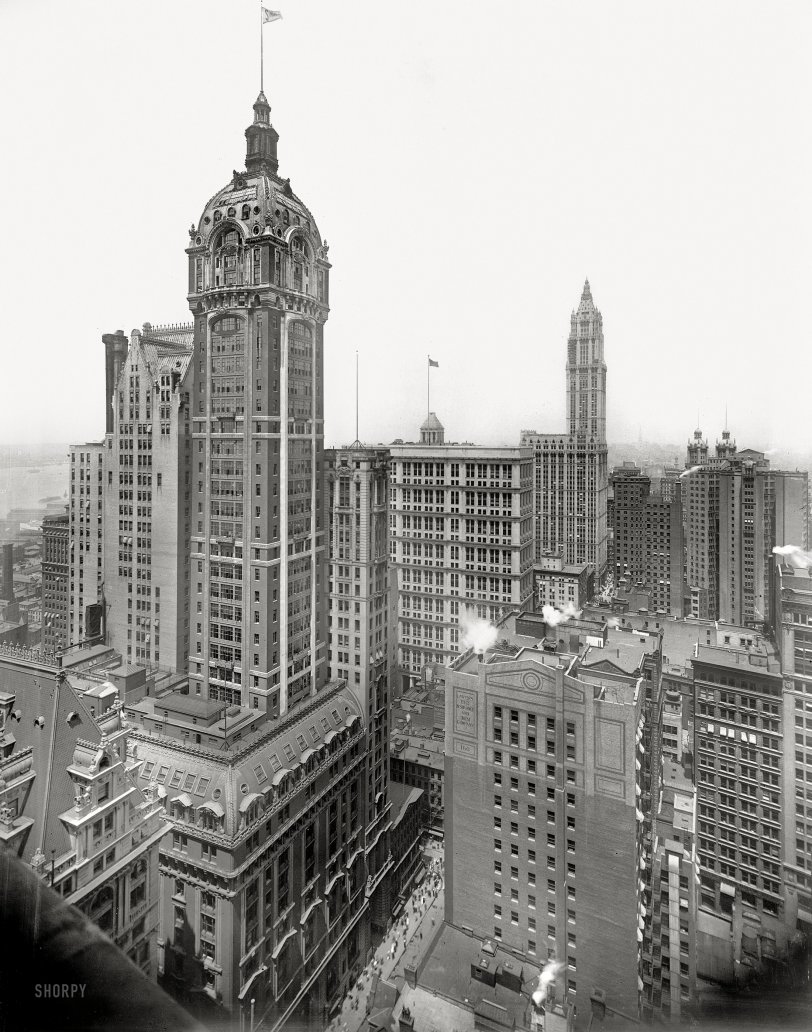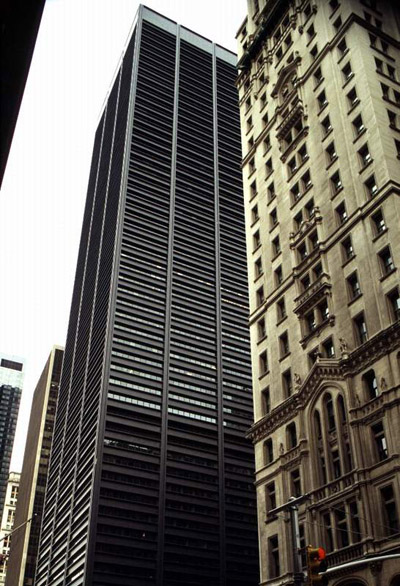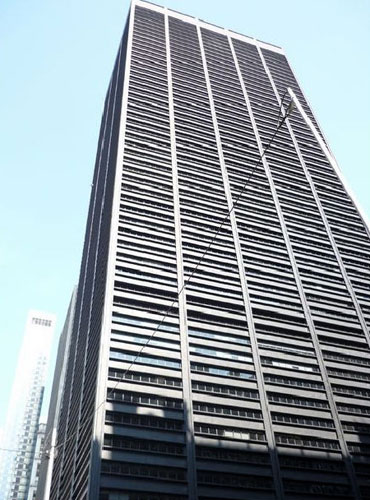


Framed or unframed, desk size to sofa size, printed by us in Arizona and Alabama since 2007. Explore now.
Shorpy is funded by you. Patreon contributors get an ad-free experience.
Learn more.

- Baldwin 62303
- Baldwin VO-1000
- Cold
- No expense spared
- Tough Guys
- Lost in Toyland
- And without gloves
- If I were a blindfolded time traveler
- Smoke Consumer Also Cooks
- Oh that stove!
- Possibly still there?
- What?!?
- $100 Reward
- Freeze Frame
- Texas Flyer wanted
- Just a Year Too Soon
- WWII -- Replacing men with women at the railroad crossing.
- Yes, Icing
- You kids drive me nuts!
- NOT An Easy Job
- I wonder
- Just add window boxes
- Icing Platform?
- Indiana Harbor Belt abides
- Freezing haze
- Corrections (for those who care)
- C&NW at Nelson
- Fallen Flags
- A dangerous job made worse
- Water Stop
Print Emporium
Singer Building: 1913

New York circa 1913. "The Singer Building." Rising in the distance, the Woolworth Building under construction. Detroit Publishing Company. View full size.
Washington Life
You can see a section of the roof of the Washington Life building in the lower left of this beautiful photograph. It was built in the German Renaissance Revival style, and was stunning. What is there now? A little strip park, across Liberty Street from the monstrous monolith 1 Liberty Plaza. Those blocks south of Cortlandt heading into the Wall Street area were so beautiful. I wish they had been preserved. The economic arguments are weak, in comparison to the importance to preserve: just as we mourn Penn Station, we should mourn the destruction of those blocks.
Precursor of the 1916 Zoning Ordinance
The architect of the Singer Tower, Ernest Flagg, believed that skyscrapers that shot straight up from the sidewalk and occupied their entire sites were a menace to the health of the city. He advocated building slender towers that occupied only 25 percent of the lot area while limiting the height of the "base buildings" below them, in order to get sunlight down to the crowded city streets. This is precisely what he did at the Singer Tower; in 1916 New York City adopted his formula for the nation's first zoning ordinance, which regulated the height and bulk of New York skyscrapers until 1961.
Shame to lose it, but --
It's a terrible aesthetic loss but the sad fact is that a building this old generally has severe handicaps for use today. Simply rewiring it for modern power (not to mention adding modern phone and computer lines) is a tremendous expense- everything is buried under plaster and masonry. These old buildings were firetraps- vast improvements over their predecessors but still dependent on someone finding a hose or fire extinguisher not all of these buildings had sprinklers. Most of these buildings depended on an open window for cooling in the summer- to refit a structure like this for modern use you've often got to strip the interior to the skeleton. Even if you could do everything needed you're up against the reality of life in NYC- the occupancy of the building might be too small to bring in enougfh money to cover costs and taxes. It's a sad thing.
Pie in the eye
Using some of the rational expressed and considering today's economic situation, the Statue of Liberty isn't carrying her weight and could be headed for the scrap yard.
[Maybe, if the Statue of Liberty were a privately owned office building. - Dave]
You can't afford it.
Even by 1967 standards, which are much much looser than today's standards, the building is not a viable commercial property. Look at how SMALL the floors of the tower are - now subtract space for ( 4 ) modern elevators, ( 2 ) fireproof stairways as far apart as possible, restrooms, an exit access corridor, plus space for structural columns, ventilation, air conditioning and heating equipment, and what you have left is somewhat less than half of the floor space for rental. This means you would have to charge exorbitant per-square-foot rent just to recover the renovation costs. Maybe today you could get away with it, just for the cachet of an exclusive address, but not in 1967.
Flag Raiser
I'd hate to be the guy that had to go up there to raise the Singer flag.
12 Fifth Avenue
I always figured that the design of the Singer Building had much in common with that of the old apartment building at 12 Fifth Avenue, on a much larger scale, of course. 12 Fifth still stands between 8th and 8th Streets on the west side of 5th. Wish I had a photo of it. I lived there for two years between 1964 and 1966. Those were the Good Old Days.
One of the all-time greats
It's a darn shame the Singer Building was demolished. It once held the title, very briefly though, as the tallest building in the world. GlenJay's right, had any decent creative thought been given to renovating the building for lucrative use, it would still be there today instead of the eye sore called 1 Liberty Plaza.
Talk is cheap
The reason the owners "thought of demolition" was they wanted to put up a big new office building that tenants would actually want to rent, and make a lot of money. Which they have every right to do. They ended up a with a building that paid a lot more in property taxes than the Singer ever did.
It's one thing to say the building should have been preserved, but, as pointed out below, the city (meaning you, the taxpayer) would have had to compensate the owners for their lost income. The money wasn't there, for understandable reasons.
Old and New
For a kid who grew up in Manhattan and Jersey City, the Singer was interesting in a grotesque kind of way, like a giant rotten tooth. Aesthetically and functionally the U.S. Steel building (which will probably long outlive the Singer) was a big improvement. Still, something was lost -- it would be nice if the Singer was still there. But that's the way it goes.

Pie in the sky, my eye
Today the building would be converted to condos or apartments (or a hotel, like the PSFS in Philadelphia) and would be a huge success. Nobody thought of that in 1967, because ... because they didn't want to think of anything except demolition.
Here's the piece of sky-pastry that the Singer Building was swapped for:

Pie in the Sky Notions
I wonder what some of the commenters here are thinking -- if you are the owner or shareholder in a piece of property, the government can tell you what to do with it (including taking a loss on it) just because people think it looks cool?
There's a limit to what tenants are willing to pay per square foot in any given building -- if there's a more attractive deal elsewhere, they'll take it. And what they were willing to pay in the Singer Building was, by the mid-1960s, less than what it cost to keep the place going. So they began to bail out, starting with the Singer Company itself.
The Landmarks Preservation Law is on shaky ground when it comes to giant office buildings -- something the preservation commission recognized when it declined to give the building Landmark status. It's private property, and the owners need to make a profit -- they'll abandon their investment or sue if the government makes a move toward de facto expropriation.
Alan Burnham, executive director of the Landmarks Preservation Commission, in 1967: "If the building were made a landmark, we would have to find a buyer for it or the city would have to acquire it. The city is not that wealthy and the commission doesn't have a big enough staff to be a real-estate broker for a skyscraper."
A real shame
Doing a little research, you can see that the newly formed NYC Landmarks Commission really failed its mission in letting this building be torn down. There is nothing else like it in NY. If you do a little net research, you can find some detailed exterior and interior pix. I wish I could have seen what those spaces are like up in the crown. It must have been spectacular.
Impressively something
Top kind of scary!
The more things changed
The Singer Building was the first big test for New York's Landmarks Preservation Commission, which was formed after the outcry over demolition of Pennsylvania Station. The Commission failed miserably, allowing the destruction of the Singer Building in 1967 on the grounds that there was nothing else to do with it. It is the largest structure ever demolished for "peaceful" (i.e. money) reasons.
Yikes.
I guess this would be the classic example of "it looked good on paper."
Quo Vadis Singer
That is just a gorgeous building. Looks like something out of "The Fountainhead." Why on earth did they let that one disappear?
























On Shorpy:
Today’s Top 5